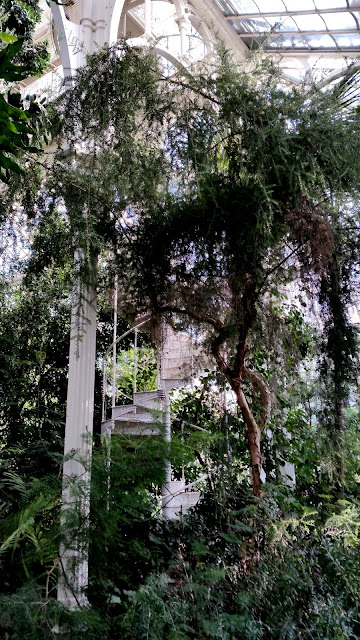At last a sunny morning so I head back to Schonbrunn Palace to have a wander through the magnificent 19th century Palm House ...
Linked by tunnel-like passages, the pavilions contain
different climatic zones: a ‘cold’ house to the north, a temperate zone in the
central pavilion and a tropical zone in the south pavilion.
The Palm House is located on the site of the former Dutch
Botanical Garden and was erected in 1881/2 to designs by Franz Xaver
Segenschmid. Built of steel, it is 113 metres long and consists of a 28-metre
high central pavilion and two lateral pavilions which are three metres lower.
The structure is covered with 45,000 glass tiles.
Several forerunners were built in the Palace Park in the 18th and 19th centuries, under Emperors Francis I and Joseph II. The present building was opened in 1882, under Franz Joseph I and since 1918 it has been run by the Bundesgärten (Federal Gardens).
Grown under glass in one of the other hot houses on the estate these magnificent yellow and white Chrysanthemums are used as display flowers to add colour to the Palm House.
A heavy bomb attack on Schönbrunn Palace in February 1945
destroyed most of the glazing of the Palmenhaus. Many plants died, although
some were saved by being transferred to the nearby Sonnenuhrhaus. The
rebuilding began in 1948, and the Palmenhaus was reopened in 1953.
This impressive iron construction used the most modern technology of its time, with the materials determining its form. The proportions of the convex and concave lines of the central and lateral pavilions are perfectly balanced and endow the iron structure with a perceptible lightness despite its massive dimensions. Inserted into the framework of the external iron construction, the glazing clings to the curved iron girders like a skin.
The varying temperatures are achieved by means of a steam heating system which means that rare specimens from all over the world can be grown here.
Four sets of spiral stairs lead to a
"mezzanine" level in the central pavilion.
Quite a spectacular feature within the grounds of this
extraordinary estate - and a nice place to spend time in the warm climate while
the temperature outside hovered around 9 degrees - even in the sunshine ...
Better look at some more indoors art in the next blog post
...






























No comments:
Post a Comment
Note: Only a member of this blog may post a comment.